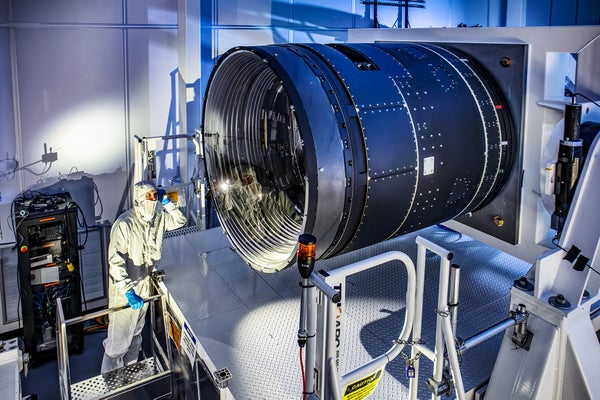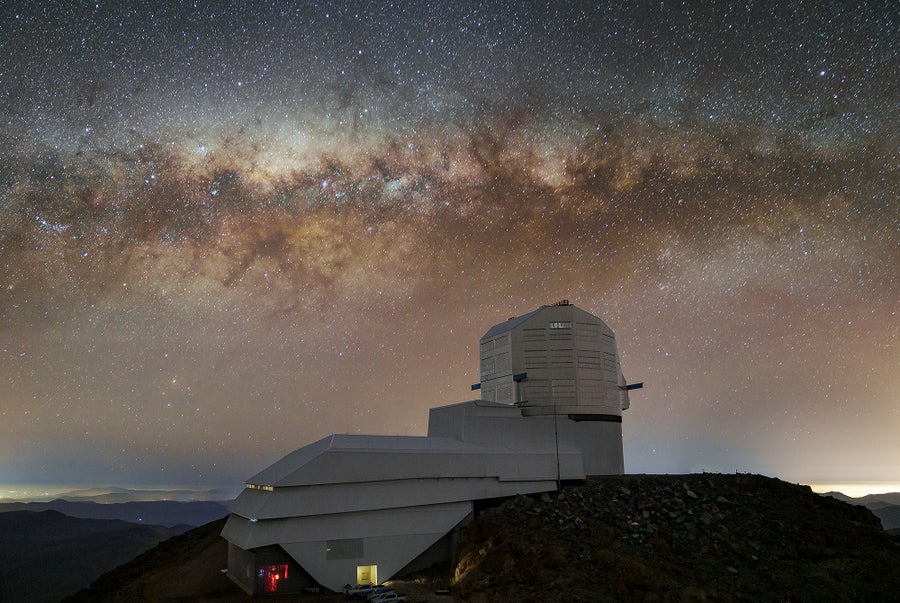How one can Transfer the World’s Largest Digital camera from a California Lab to an Andes Mountaintop
A multimillion-dollar digital digicam might revolutionize astronomy. However first it must climb a mountain midway across the globe

A employee shines a flashlight into the Vera C. Rubin Observatory’s digicam.
J. Ramseyer Orrell/SLAC Nationwide Accelerator Laboratory/NOIRLab (CC BY 4.0)
By late subsequent yr, if all goes to plan, the Vera C. Rubin Observatory may have began its 10-year survey of the photo voltaic system, Milky Approach and galaxies past. Its large eye on the southern skies is a 3.2-gigapixel camera with the scale and weight of a small automobile. By mass and pixel decision, it’s the largest digital digicam on Earth. It can scan the cosmos from atop a mountain known as Cerro Pachón in northern Chile.
There is only one hitch: the fragile, practically three-metric-ton machine is at the moment some 10,000 kilometers away within the hills above San Francisco Bay, the place its builders have put it via last exams. Within the coming weeks the exactly engineered digicam will start a tense intercontinental voyage by which it is going to be flown by cargo aircraft, hauled by truck and painstakingly escorted up twisty mountain roads.
The daunting logistics fall to members of an obscure however consequential engineering subfield devoted to retaining multimillion-dollar astronomy {hardware} intact in transit. That is “a really apparent and visual second when issues can go flawed,” says engineer Margaux Lopez of the Rubin Observatory and the SLAC Nationwide Accelerator Laboratory, who’s answerable for the trouble.
On supporting science journalism
If you happen to’re having fun with this text, contemplate supporting our award-winning journalism by subscribing. By buying a subscription you might be serving to to make sure the way forward for impactful tales concerning the discoveries and concepts shaping our world at this time.
The Rubin digicam’s journey begins in a clear room in Silicon Valley, the place SLAC will outfit the digicam with a steel-and-wire-rope exoskeleton. “It’s a body sitting on springs on one other body, primarily,” says SLAC and Rubin engineer Martin Nordby. This defend will maintain the digicam tucked inside the confines of a typical transport container and defend its delicate innards from vibrations. Then, over two days in Might, SLAC personnel will drive the digicam’s container and 49 crates of apparatus to San Francisco Worldwide Airport, the place every part might be packed aboard a chartered Boeing 747 cargo aircraft for the 16-hour flight to the Arturo Merino Benítez Worldwide Airport in Santiago, Chile.
The Rubin group is comparatively fortunate: components of different telescopes in growth, additionally sure for observatories below Chile’s exceptionally clear skies, should spend weeks touring at sea. When the Fred Younger Submillimeter Telescope sends its five-story-tall support structure—too giant to suit right into a freight plane—from Germany to Chile, it should have to take action through break-bulk cargo ship by the use of Antwerp, Belgium.
The Extraordinarily Giant Telescope (ELT)’s giant mirrors are taking the ocean route from Europe to Chile, too. “Traditionally…, we shipped principally every part by aircraft, however with the brand new kind of sizes we’re speaking about with the ELT, planes both will not be sufficiently big or the prices are ridiculously excessive,” says Hervé Kurlandczyk, an engineer for the European Southern Observatory, who works on ELT and isn’t concerned with the Rubin venture.
Bodily harm is all the time a menace, irrespective of the route or mode of transport. Astronomy, by design, requires among the most delicate parts on the earth. Something from bumps within the highway to turbulence within the air can rattle delicate electronics or jostle painstakingly positioned components out of alignment. Mirrors, together with Rubin’s pieces that arrived in Chile in 2019, could require refrigeration and humidity controls or threat harm to their coating.
Transit brings different attainable complications which can be acquainted to anybody skilled in worldwide transport. Unhealthy climate and different snafus can redirect or stall transports. A number of years in the past miscommunication precipitated the container ship carrying a part of the Simons Observatory to sit down at anchor for 2 weeks off Chile, leaving observatory workers scratching their head in port. Even observatories must clear customs, particularly when exiting the U.S.; astronomical devices made within the U.S. could, for instance, run into government export controls designed to maintain superior optical expertise inside the nation’s borders.
All these worries imply engineers attempt “to regulate, as a lot as attainable, each single step of the entire chain,” Kurlandczyk says. Though Santiago is on the opposite facet of the equator from San Francisco, SLAC will proceed to supervise the digicam’s transit inside Chile. As soon as the 747 lands, its cargo might be loaded right into a caravan of 9 automobiles—every much like the curtain-side vehicles used to move drinks and outfitted with air-ride suspensions for extra safety from vibrations. The caravan’s six-hour highway journey to the bottom of Cerro Pachón might be a prelude to essentially the most arduous a part of the voyage: getting the digicam from the bottom of the mountain to the observatory atop one in every of its peaks.

Rubin Observatory/NOIRLab/NSF/AURA/H. Stockebrand (CC BY 4.0)
This final leg might be a 35-kilometer journey up a winding snake of dust roads and switchbacks. It is going to be slim and dangerous, and the observatory on the high gained’t have the ability to obtain multiple truck at a time, so the method will take three days, with three vehicles per day. And the truck carrying the digicam itself, escorted in entrance and behind by observatory automobiles, will have the ability to journey no quicker than 10 kilometers per hour. Lopez says the digicam’s ascent will take 5 hours to make a visit that takes most different cargo about 90 minutes.
Lopez and her colleagues can take some consolation in the truth that they’ve already practiced nearly each step of the journey utilizing dummies with the identical mass because the telescope components. They’ve loaded these weights into vehicles pushed up and down the freeways of the San Francisco Peninsula and alongside Chilean roads; they’ve even rehearsed the flight from California to Chile.
“Each time we deal with one thing, it’s primarily the primary time it’s ever been completed,” Lopez says. “We’ve spent a number of effort to determine methods to follow these delicate procedures with one thing that’s not as fragile earlier than we do it with, you realize, $25-million optics.”
Greater than 5 years of preparation have gone into the digicam’s six-day journey. “This has to work. It must be profitable. We can’t break something alongside the way in which or lose something or—decide your favourite failure mode,” Lopez says. “However we have now a extremely stable logistics plan, and we’re able to go.”




